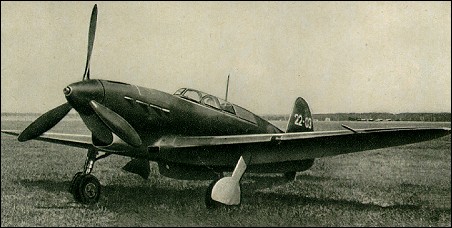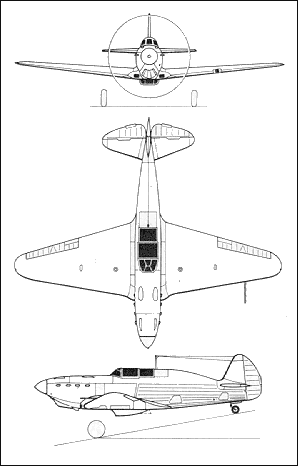|
| In parallel with the I-26 (or Ya-26), the Yakovlev design bureau developed a two-seat version under the designation Yakovlev Ya-27. One pre-production I-26 was completed to this configuration. It was intended to serve not only as a dual-control fighter trainer, but also as a liaison and unit support aircraft. Compared with the I-26, the Ya-27 was simplified and of reduced weight, the tandem cockpits being enclosed by an extended glazed canopy. The resulting Yak-7 aircraft entered production in May 1941 and was soon found to have better flying qualities than those displayed by series Yak-1s. This performance, combined with the urgent need for more fighters, led to production of a single-seat version of which the first was flown in June 1941; in the following month the fighter was officially designated Yak-7A and the two-seater Yak-7V. By the end of 1941 a new single-seater, the Yak-7B, had replaced the Yak-7A . Total delivery of all versions of the Yak-7 was 6,399 aircraft, production terminating in early 1943; of this number, some 1,500 were Yakovlev Yak-7Vs.

| CREW | 1 |
| ENGINE | 1 x VK-105PF, 870kW |
| WEIGHTS |
| Take-off weight | 3050 kg | 6724 lb |
| Empty weight | 2330 kg | 5137 lb |
| DIMENSIONS |
| Wingspan | 10.0 m | 33 ft 10 in |
| Length | 8.5 m | 28 ft 11 in |
| Height | 1.7 m | 6 ft 7 in |
| Wing area | 17.2 m2 | 185.14 sq ft |
| PERFORMANCE |
| Max. speed | 520 km/h | 323 mph |
| Ceiling | 10000 m | 32800 ft |
| Range | 600 km | 373 miles |
| ARMAMENT | 1 x 20mm machine-guns, 2 x 12.7mm machine-guns |
| Klaatu83, e-mail, 18.02.2017 22:44 The Yak-7 represents one of the rare instances of a trainer being successfully converted into a fighter. The Yak-7 was originally designed to be a 2-seat advanced trainer for training pilots to fly the Yak-1 fighter, and was built in a different factory than the Yak-1. However, the need for fighters was so great that the Yak-7 was redesigned into a single-seat fighter and manufactured in quantity. The Yak-7 proved to be such a successful combat aircraft that the improved Yak-9 Fighter was developed directly from it rather than from the Yak-1. reply | | brian, e-mail, 16.11.2011 23:04 Im looking for stats on the yak-9m with vk105pf-2 engine. reply | | Ron, e-mail, 28.08.2010 04:06 Leo,
Most all Yaks were without chin scoops in the last year of the war; the Yak-3 (the plane the directive had in mind), and the newer Yak-9U. Other Yaks (with the chin scoop) were left over from earlier and these were rapidly in the minority.
This left the Luftwaffe trying to avoid virtually all Soviet fighters but Lavochkins and Bells for the most part by that time. Thus aces of these planes scored well. reply | | Leo Rudnicki, e-mail, 09.06.2009 21:33 Luftwaffe pilots were advised to avoid combat with Yaks without nose-mounted oil coolers (Yak-3) reply | |
| | Ronald, e-mail, 09.06.2009 07:55 Heavy vs light. These were the 2 branches of the Yakovlev fighters of WW 2. The Yak-7 became the Yak-9 and the lighter Yak-1 became the Yak-3. In combat many units mixed them together. I can imagine it kept the German pilots guessing.
Even the Yak-9B carried bombs internally. From any distance you couldn't tell which Yak could out-turn you the best (-1B), which one could out-gun you (-9T), which could out-last you (internal fuel -9DD), which one could out-roll you (-3), which could out-fly you at high altitude (-9U), and which one was the fighter-bomber with a mission (-9B). reply | | Sgt.KAR98, 19.01.2009 06:18 Whats the difference between Yak-1 and 7? reply | | Ronald, e-mail, 02.09.2008 08:02 Weight of fire / sec. salvo = 2.72kg
Climb to 5km = 5.8 min.
360 turn = under 20 sec. reply |
|
Do you have any comments?
|
| 
COMPANY
PROFILE
All the World's Rotorcraft
|








